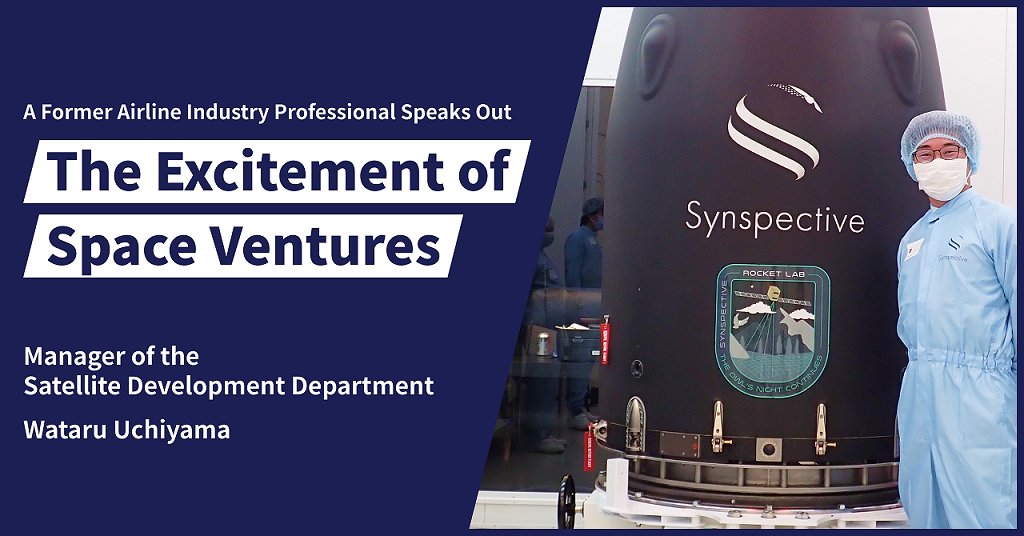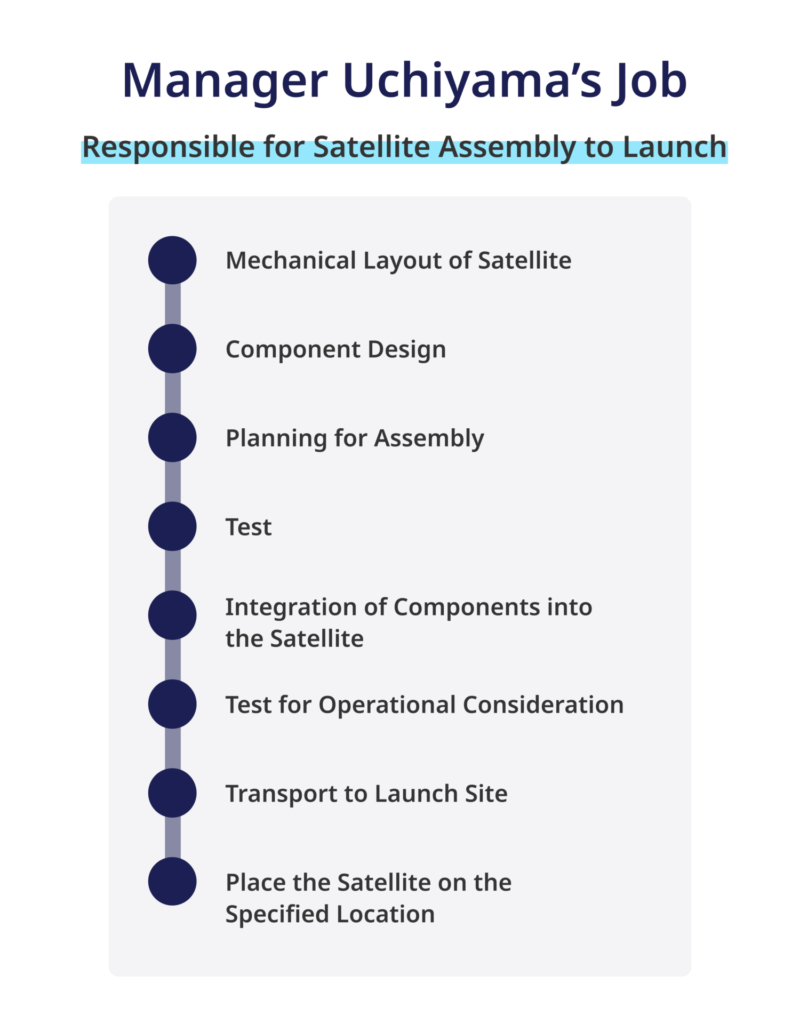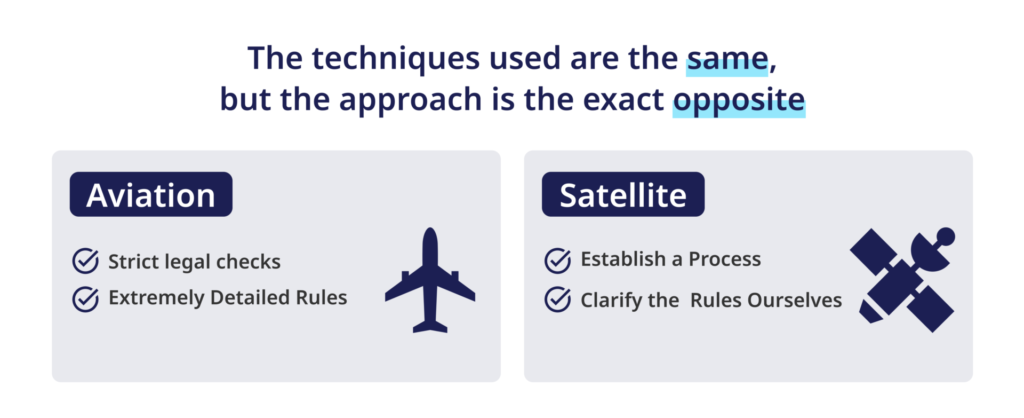
Synspective creates a learning world where people can expand their capabilities and make tangible progress with new data and technologies. We develop and operate small satellites equipped with radio frequency sensors called synthetic aperture radar (SAR), and provide solutions using satellite data.
We are currently recruiting Satellite Development Engineers who are responsible for the overall process, from satellite assembly to loading the satellite onto a launching rocket.We asked Mr. Wataru Uchiyama, Manager of the AIT (Assembly, Integration, and Test) Unit of the Satellite Development Department, to talk about his role and experiences at Synspective, what he values in his work, and his vision for the future.
(Photo) Wataru Uchiyama
Mr. Uchiyama joined Synspective in October 2019 after working in design and planning for commercial aircraft components for nearly two decades. He is currently in charge of operations as Manager of the Satellite Development Department’s AIT Unit.
■ Engage in a Wide Range of Activities from Satellite Assembly to Launch
──Please tell us about your current role.
Briefly, I am the manager of the team responsible for the satellite from assembly to loading onto the launch vehicle.
Specifically, the mechanical layout of the satellite and its components are designed, planning is done for assembly, and the finished development of each piece of equipment is finally incorporated into the satellite. Then comes the testing. Testing is done both before and after integration.
After the satellite has taken shape, various tests are conducted to simulate actual operation and, upon completion, the satellite is transported to the launch site by a carrier. At the launch site, I am in charge of placing the satellite in the designated location inside the rocket. My involvement ranges from design to launch.
I am still in New Zealand for the launch. (*Remote coverage in January 2022)

──I see. Is your work schedule often irregular since you have to travel overseas for launches?
Launches are irregular, but I work in a more normal fashion than you might think.
Since our base is manufacturing, we have to work in a planned, factory-like manner. We have to assemble, make the product together, and control it so that everyone finishes in the same way. Therefore, there are not many irregularities that require us to work on weekends. Also, since we are still very much a manual labor operation, working late into the night can have damaging effects the next day. In order to ensure stable performance, we are building our team in a way that we do not have to work overtime or on holidays.
──How did you come to join Synspective?
Actually, there was initially no major trigger. I was introduced to the company by an agent, and when I heard about it, things started to flow in that direction. If I had to give a single reason, I joined because there were many people at Synspective that I wanted to be around and work with. I was also compelled by the fact that the company was trying to be very open and encouraging everyone’s ideas.
Additionally, since I had previously worked for a manufacturer-affiliated company, it felt normal to collaborate throughout the process and also refreshing to have personal conversations with everyone around me.
──Before joining the company, what type of company did you work for?
My longest involvement was in making airplane parts for commercial aircraft. I was in charge of design and planning for almost 20 years. I changed companies during that time but the details of my work didn’t drastically change.
──What exactly were the parts that you were making?
I made composite materials for airplanes, what we call carbon. When I was younger, I was also involved in wing design.
■ “Do I Understand the Essence of What I am Doing?”
──What differences do you feel you’ve seen in your career change from actually making aircraft parts?
While the technology we use is the same, I feel that our approach to the goal is quite the opposite. Aircraft is a world where safety comes first and is very bound by law and regulation; there are basically rules for everything. However, it’s quite the contrary here where we first establish a process before engaging with the regulatory and legal considerations. So, even though the technology we use is the same, the approach has changed.

In the design world, you often hear that accidents lead to good results but that’s not the case with airplanes where accidents must be absolutely zero. The rules are set in a way to prevent people from stepping off the ladder.
By contrast, it feels like we are building the ladder here with our own hands and clarifying the rules ourselves. For example, we know what needs to be done but we don’t have a clear idea of who is supposed to do it. We have to do it all ourselves. So, if you enjoy that, I think you would be a good fit in the satellite industry.
That said, there are of course difficulties but it’s the difficulties that have allowed me to grow here at Synspective.
──What did you find interesting when you joined?
I was in an established organization before I came here, and I am enjoying the fact that we have gone from having few people to having many different people, allowing us to do a lot that we couldn’t do before.
In my previous job, I was in charge of setting up a foreign factory but wasn’t closely involved with problem-solving processes. The industry of business using satellites is much newer than the aviation industry. There are still many things that no one knows and we have to go and seek them out ourselves.
──What do you value in your work?
In terms of technology, I always ask myself whether I understand the essence of what I am doing. I can’t do everything from top down in terms of the way I think, design, and manufacture. When we test, errors occur where we didn’t quite think it through enough or were concerned enough about something.
In a repairable environment, we can say, “If it doesn’t work, let’s try it again,” but since we are in space, we don’t know why it broke in the first place. So, we try to proceed with as much reasoned thinking as possible.
──Do you mean that the satellite blueprint will be updated by understanding and filling in the essence of the technology?
There will be some updates, but I think it would be more appropriate to add more notes to get to that idea. For example, to make a checklist every time.
Right now, there are so many things we don’t know so we can’t even judge whether it is dangerous or not. I think we need to know everything we can so that we can judge whether something is dangerous or not.
──What has surprised you most at Synpective?
The sense of speed. It was only when I came here that I thought that we could really progress quickly. I am still amazed!
──How exactly did the process differ from your previous experience?
The big difference is that we don’t wait and, because of that, we have been able to achieve a lot in a relatively short period of time. Looking back, waiting and time wasted caused me a lot of pain.
■Bring a High Level of Professionalism to the Table
──What are your future plans?
Personally, I would like to make the organization a place where people with a high level of professionalism can come. I would like to create a place where people who say, “I will live by this technology,” are comfortable and attracted to our mission and values.
Also, it may be very presumptuous of me but I want to produce global-level satellites or at least the very best satellites in Japan. I would like to create unique satellites that are even better than the high quality satellites that we currently make.
──Lastly, is there anything you would like to share with those who are considering joining the company?
By working at Synspective, you may be able to create a world that has never existed before. I hope we can tackle new challenges together.
──Thank you!
Why don’t you join the journey at Synspective?
You can find open positions here.

